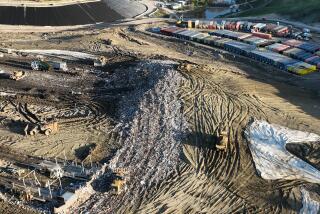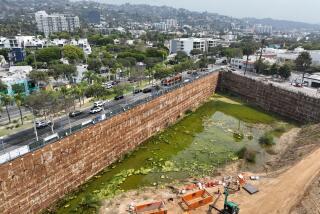Mystery of the Nightly Release of Water Solved : Thousand Oaks: Tara Reservoir is being drained after maintenance work gave the supply a slight odor and taste.
It could have been a scene from “Chinatown,” the famous movie about Southern California water shenanigans.
The last three nights had Fred Tonsing mystified as millions of gallons of water roared through a culvert and into an arroyo behind his Thousand Oaks residence, then on to local creeks and finally the sea.
But it turned out Thursday that there was a relatively simple answer to the mystery of the missing water.
As it turns out, the city is draining the nearby 3.8-million-gallon Tara Reservoir because maintenance on the structure gave the water a slight, albeit harmless, odor and taste.
Nonetheless, Tonsing is still irked that the city is merely dumping the water instead of putting it to good use during these times of water conservation.
“There should be some way of capturing that water,” said Tonsing, who strictly monitors his water usage. “It’s just gone.”
But Don Nelson, the city’s director of utilities, said it just can’t be done.
“I recognize it may look like a waste of water,” said Nelson, saying the water in the reservoir could service 10 families for one year. “Nor do we want to release water into the potable system that is objectionable to customers.”
He said the interior of the Tara Reservoir had just been re-coated to prevent rust from forming in the aboveground steel structure. It is a common maintenance practice, done every 10 to 15 years.
The reservoir is among three being re-coated as part of a $278,000 city project. Two others are undergoing structural modifications for earthquakes, as well as the re-coating, for another $415,000.
Before the re-coating is begun, the reservoir’s water is diverted to the city’s potable supply. Afterward, the reservoir is refilled and tested for the petroleum-like odor that the coating emits. If it doesn’t pass, the water is dumped.
This has been the practice, Nelson said, since the early 1980s, when the city released some water into the system that retained the petroleum odor.
“After receiving a number of taste and odor complaints the entire water-service zone was flushed which resulted in water outages for our customers and the reservoir was drained and filled several times,” he said in a city memo.
He said it would be impractical for the city to slowly use the smelly water for irrigation or other uses. The water must be disposed of quickly, Nelson said.
“The major purpose (of the reservoir) is to provide water for fire suppression,” he said. “The very last thing any of us wants is to have the reservoir out of service in a major fire.”
There was nothing unusual about releasing the water at night either, he said, saying that it’s customary to do such work at night, and that it disturbs residents less in the evening than during the day.
But Tonsing didn’t agree.
“It was a little hard to sleep with the noise,” he said. Each night the noise began about dusk and continued until dawn. He said residents are used to an occasional release of water for a short time, but never all night.
“The thing that disturbs me is that for years we’ve been conscientious about water, cutting out everything we could,” said Tonsing, who times his lawn watering.
Only a few residents called the city about the release of water. One of Tonsing’s neighbors said she liked the sound.
“It sounds a little like a river,” she said, asking not be identified. But she was concerned about the loss of water.
“With the price of water, that bothers me,” she said.
More to Read
Sign up for Essential California
The most important California stories and recommendations in your inbox every morning.
You may occasionally receive promotional content from the Los Angeles Times.









